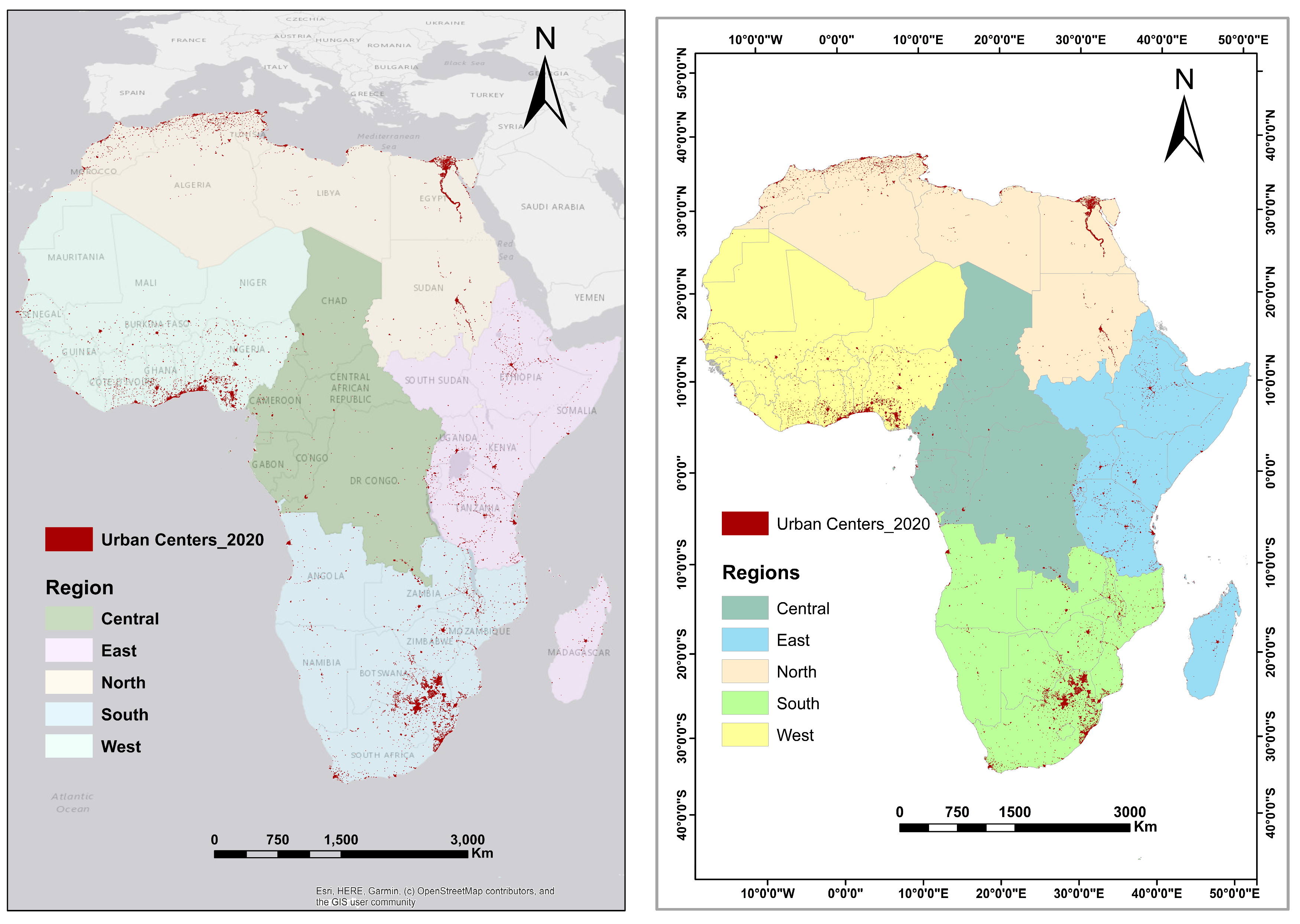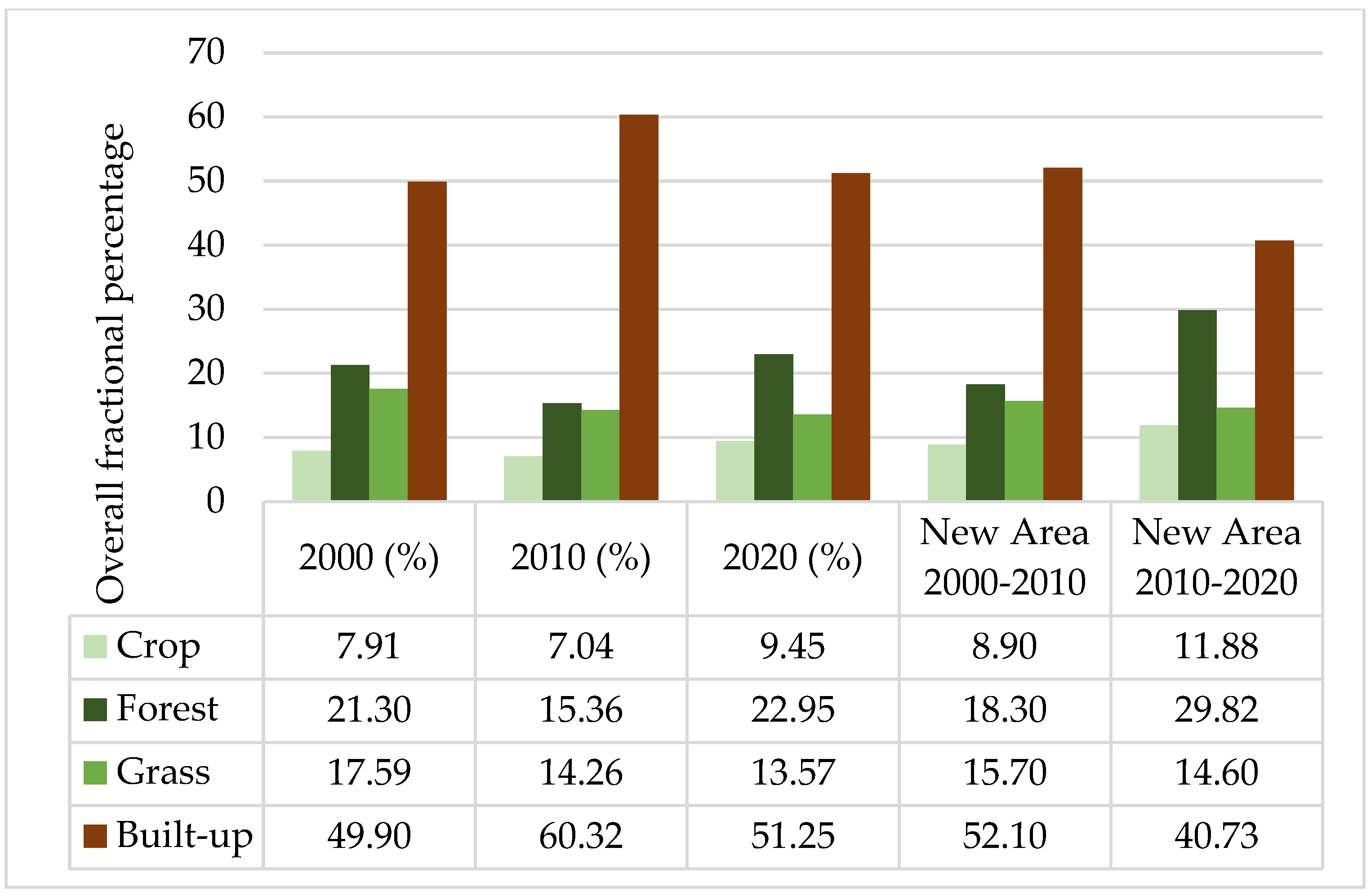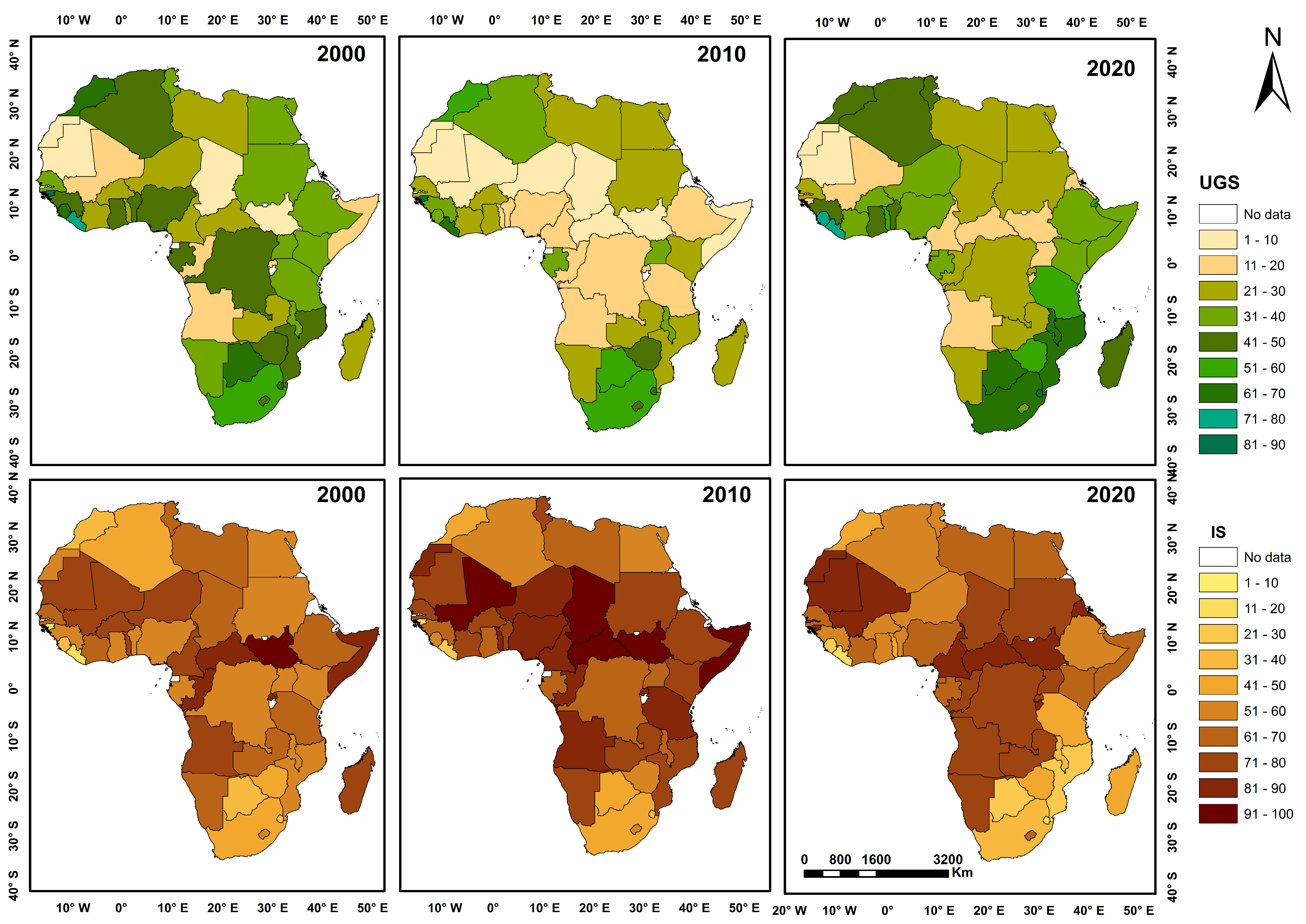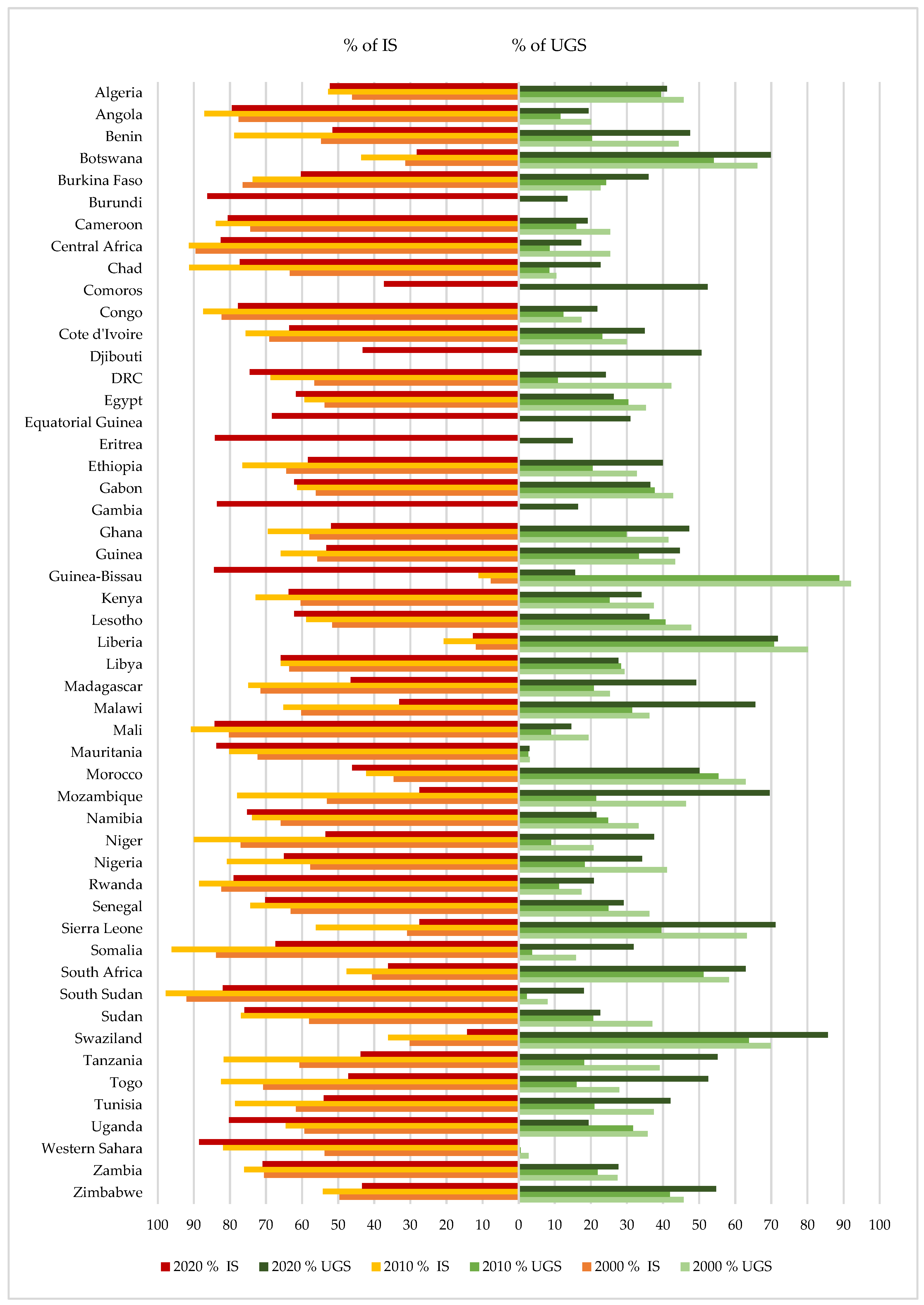Urban Land Expansion and Spatiotemporal Dynamics of Urban Green Spaces in Africa
Abstract
:1. Introduction
2. Materials and Methods
2.1. Study Area
2.2. Methods
2.2.1. Urban Expansion
2.2.2. Evaluating Green Spaces and Impervious Surfaces Changes
3. Results
3.1. Urban Growth Dynamics
3.2. Spatiotemporal Dynamics of Green Spaces and Built-Up Areas
4. Discussion
4.1. Urban Land Expansion
4.2. Green Spaces and Impervious Surfaces Dynamics
4.3. Limitations and Future Study
5. Conclusions
Author Contributions
Funding
Institutional Review Board Statement
Informed Consent Statement
Data Availability Statement
Acknowledgments
Conflicts of Interest
References
- Liu, Y.; Yang, M.; Cui, J. Urbanization, economic agglomeration and economic growth. Heliyon 2024, 10, e23772. [Google Scholar] [CrossRef]
- Zhong, C.; Guo, H.; Swan, I.; Gao, P.; Yao, Q.; Li, H. Evaluating trends, profits, and risks of global cities in recent urban expansion for advancing sustainable development. Habitat Int. 2023, 138, 102869. [Google Scholar] [CrossRef]
- Zhao, Q.; Gao, L.; Meng, Q.; Zhu, M.; Xiong, M. Nonlinear causal relationships between urbanization and extreme climate events in China. J. Clean. Prod. 2024, 434, 139889. [Google Scholar] [CrossRef]
- Zhou, D.; Xiao, J.; Frolking, S.; Zhang, L.; Zhou, G. Urbanization Contributes Little to Global Warming but Substantially Intensifies Local and Regional Land Surface Warming. Earths Future 2022, 10, e2021EF002401. [Google Scholar] [CrossRef]
- Cao, J.; Zhou, W.; Yu, W.; Hu, X.; Yu, M.; Wang, J.; Wang, J. Urban expansion weakens the contribution of local land cover to urban warming. Urban Clim. 2022, 45, 101285. [Google Scholar] [CrossRef]
- Gao, S.; Chen, Y.; Chen, D.; He, B.; Gong, A.; Hou, P.; Li, K.; Cui, Y. Urbanization-induced warming amplifies population exposure to compound heatwaves but narrows exposure inequality between global North and South cities. npj Clim. Atmos. Sci. 2024, 7, 154. [Google Scholar] [CrossRef]
- European Commission. Towards an EU Research and Innovation Policy Agenda for Nature-Based Solutions & Re-Naturing Cities: Final Report of the Horizon 2020 Expert Group on ‘Nature-Based Solutions and Re-Naturing Cities’; Publications Office: Luxembourg, 2015. [Google Scholar]
- IUCN. Nature-Based Solutions to Address Global Societal Challenges; IUCN International Union for Conservation of Nature: Gland, Switzerland, 2016. [Google Scholar] [CrossRef]
- Nassary, E.K.; Msomba, B.H.; Masele, W.E.; Ndaki, P.M.; Kahangwa, C.A. Exploring Urban Green Packages as Part of Nature-Based Solutions for Climate Change Adaptation Measures in Rapidly Growing Cities of the Global South; Academic Press: Cambridge, MA, USA, 2022. [Google Scholar] [CrossRef]
- Dondina, O.; Tirozzi, P.; Viviano, A.; Mori, E.; Orioli, V.; Tommasi, N.; Tanzi, A.; Bazzoli, L.; Caprio, E.; Patetta, C.; et al. Spatial and habitat determinants of small-mammal biodiversity in urban green areas: Lessons for nature-based solutions. Urban For. Urban Green. 2025, 104, 128641. [Google Scholar] [CrossRef]
- Bourgeois, M.; Boutreux, T.; Vuidel, G.; Savary, P.; Piot, P.; Bellec, A.; Kaufmann, B. Assessing the strategic role of urban green spaces for habitat connectivity in multi-family residential plots. Urban For. Urban Green. 2024, 99, 128471. [Google Scholar] [CrossRef]
- Ai, H.; Zhang, X.; Zhou, Z. The impact of greenspace on air pollution: Empirical evidence from China. Ecol. Indic. 2023, 146, 109881. [Google Scholar] [CrossRef]
- Selmi, W.; Weber, C.; Riviere, E.; Blond, N.; Mehdi, L.; Nowak, D. Air pollution removal by trees in public green spaces in Strasbourg city, France. Urban For. Urban Green. 2016, 17, 192–201. [Google Scholar] [CrossRef]
- Gillerot, L.; Landuyt, D.; De Frenne, P.; Muys, B.; Verheyen, K. Urban tree canopies drive human heat stress mitigation. Urban For. Urban Green. 2024, 92, 128192. [Google Scholar] [CrossRef]
- Wong, N.H.; Tan, C.L.; Kolokotsa, D.D.; Takebayashi, H. Greenery as a mitigation and adaptation strategy to urban heat. Nat. Rev. Earth Environ. 2021, 2, 166–181. [Google Scholar] [CrossRef]
- Wang, Q.; Peng, J.; Yu, S.; Dan, Y.; Dong, J.; Zhao, X.; Wu, J. Key attributes of greenspace pattern for heat mitigation vary with urban functional zones. Landsc. Ecol. 2023, 38, 2965–2979. [Google Scholar] [CrossRef]
- Koprowska, K.; Laszkiewicz, E.; Kronenberg, J.; Marcinczak, S. Subjective perception of noise exposure in relation to urban green space availability. Urban For. Urban Green. 2018, 31, 93–102. [Google Scholar] [CrossRef]
- Margaritis, E.; Kang, J. Relationship between urban green spaces and other features of urban morphology with traffic noise distribution. Urban For. Urban Green. 2016, 15, 174–185. [Google Scholar] [CrossRef]
- Aerts, R.; Honnay, O.; Van Nieuwenhuyse, A. Biodiversity and human health: Mechanisms and evidence of the positive health effects of diversity in nature and green spaces. Br. Med. Bull. 2018, 127, 5–22. [Google Scholar] [CrossRef]
- Houlden, V.; Jani, A.; Hong, A. Is biodiversity of greenspace important for human health and wellbeing? A bibliometric analysis and systematic literature review. Urban For. Urban Green. 2021, 66, 127385. [Google Scholar] [CrossRef]
- UN-Habitat. World Cities Report 2022: Envisaging the Future of Cities; UN-Habitat: Nairobi, Kenya, 2022. [Google Scholar]
- United Nations. World Urbanization Prospects the 2018 Revision; United Nations: New York, NY, USA, 2019. [Google Scholar]
- Abass, K.; Buor, D.; Afriyie, K.; Dumedah, G.; Segbefi, A.Y.; Guodaar, L.; Garsonu, E.K.; Adu-Gyamfi, S.; Forkuor, D.; Ofosu, A.; et al. Urban sprawl and green space depletion: Implications for flood incidence in Kumasi, Ghana. Int. J. Disaster Risk Reduct. 2020, 51, 101915. [Google Scholar] [CrossRef]
- Abass, K.; Adanu, S.K.; Agyemang, S. Peri-urbanisation and loss of arable land in Kumasi Metropolis in three decades: Evidence from remote sensing image analysis. Land Use Policy 2018, 72, 470–479. [Google Scholar] [CrossRef]
- Puplampu, D.A.; Boafo, Y.A. Exploring the impacts of urban expansion on green spaces availability and delivery of ecosystem services in the Accra metropolis. Environ. Chall. 2021, 5, 100283. [Google Scholar] [CrossRef]
- Urban, M.C.; Alberti, M.; De Meester, L.; Zhou, Y.; Verrelli, B.C.; Szulkin, M.; Schmidt, C.; Savage, A.M.; Roberts, P.; Rivkin, L.R.; et al. Interactions between climate change and urbanization will shape the future of biodiversity. Nat. Clim. Change 2024, 14, 436–447. [Google Scholar] [CrossRef]
- Anderson, B.; Prieto-Curiel, R.; Patiño, J. City Shapes and Climate Change in Africa; West African Papers; OECD: Paris, France, 2023. [Google Scholar] [CrossRef]
- Chitonge, H.; Mfune, O. The urban land question in Africa: The case of urban land conflicts in the City of Lusaka, 100 years after its founding. Habitat Int. 2015, 48, 209–218. [Google Scholar] [CrossRef]
- Yirga Ayele, B.; Megento, T.L.; Habetemariam, K.Y. The governance and management of green spaces in Addis Ababa, Ethiopia. Heliyon 2022, 8, e09413. [Google Scholar] [CrossRef]
- Wijesinghe, A.; Thorn, J.P.R. Governance of urban green infrastructure in informal settlements of windhoek, Namibia. Sustainability 2021, 13, 8937. [Google Scholar] [CrossRef]
- de Oliveira, J.A.P.; Ahmed, A. Governance of urban agriculture in African cities: Gaps and opportunities for innovation in Accra, Ghana. J. Clean. Prod. 2021, 312, 127730. [Google Scholar] [CrossRef]
- Jiang, L.; Deng, X.; Seto, K.C. The impact of urban expansion on agricultural land use intensity in China. Land Use Policy 2013, 35, 33–39. [Google Scholar] [CrossRef]
- Anderson, B.; Patiño Quinchia, J.E.; Prieto Curie, R. Boosting African Cities’ Resilience to Climate Change: The Role of Green Spaces; OECD: Paris, France, 2022. [Google Scholar] [CrossRef]
- Ofori, S.A.; Asante, F.; Boatemaa Boateng, T.A.; Dahdouh-Guebas, F. The composition, distribution, and socio-economic dimensions of Ghana’s mangrove ecosystems. J. Environ. Manag. 2023, 345, 118622. [Google Scholar] [CrossRef]
- Donaldson, R.; Ferreira, S.; Didier, S.; Rodary, E.; Swanepoel, J. Access to the urban national park in Cape Town: Where urban and natural environment meet. Habitat Int. 2016, 57, 132–142. [Google Scholar] [CrossRef]
- Venter, Z.S.; Shackleton, C.M.; Van Staden, F.; Selomane, O.; Masterson, V.A. Green Apartheid: Urban green infrastructure remains unequally distributed across income and race geographies in South Africa. Landsc. Urban Plan. 2020, 203, 103889. [Google Scholar] [CrossRef]
- Shackleton, C.M.; Gwedla, N. The Legacy Effects of Colonial and Apartheid Imprints on Urban Greening in South Africa: Spaces, Species, and Suitability. Front. Ecol. Evol. 2021, 8, 579813. [Google Scholar] [CrossRef]
- Chen, L.; Chen, M.; Zhang, X.; Xian, Y. Evaluating inequality divides in urban development intensity between the Global North and South. Land Use Policy 2024, 145, 107291. [Google Scholar] [CrossRef]
- Han, Y.; He, J.; Liu, D.; Zhao, H.; Huang, J. Inequality in urban green provision: A comparative study of large cities throughout the world. Sustain. Cities Soc. 2023, 89, 104229. [Google Scholar] [CrossRef]
- King, A.; Shackleton, C.M. Maintenance of public and private urban green infrastructure provides significant employment in Eastern Cape towns, South Africa. Urban For. Urban Green. 2020, 54, 126740. [Google Scholar] [CrossRef]
- Adeleke, T.G.; Ikudayisi, A.E.; Adegbehingbe, V.O. Evaluation of Maintenances of Green Open Spaces in Urban Area, A case study of the Federal University of Technology Akure, Nigeria. In Proceedings of the 2018 AARCHES National Conference, Zaria, Nigeria, 21–24 February 2018. [Google Scholar]
- Takyi, E.; Mensah, H.; Aazore, F.K.; Nalumu, D.J.; Abu, J.J. Understanding the Urban Planning-Green Space Depletion Nexus: Insights from the Kwabre East Municipality, Ghana. Urban Forum 2022, 34, 319–342. [Google Scholar] [CrossRef]
- Eshetu, S.B.; Yeshitela, K.; Sieber, S. Urban green space planning, policy implementation, and challenges: The case of Addis Ababa. Sustainability 2021, 13, 11344. [Google Scholar] [CrossRef]
- Arku, G.; Yeboah, I.E.A.; Nyantakyi-Frimpong, H. Public parks as an element of urban planning: A missing piece in Accra’s growth and development. Local Environ. 2016, 21, 1500–1515. [Google Scholar] [CrossRef]
- Amado, M.; Rodrigues, E.; Poggi, F.; Pinheiro, M.D.; Amado, A.R.; José, H. Using different levels of information in planning green infrastructure in Luanda, Angola. Sustainability 2020, 12, 3162. [Google Scholar] [CrossRef]
- Dipeolu, A.A.; Ibem, E.O. Green infrastructure quality and environmental sustainability in residential neighbourhoods in Lagos, Nigeria. Int. J. Urban Sustain. Dev. 2020, 12, 267–282. [Google Scholar] [CrossRef]
- AboElata, A.A.A. Study the Vegetation as Urban Strategy to Mitigate Urban Heat Island in Mega City Cairo. Procedia Environ. Sci. 2017, 37, 386–395. [Google Scholar] [CrossRef]
- Brown, D. Emerging African towns are critical urban planning priorities: A research agenda for the sub-continent. Cities 2024, 154, 105347. [Google Scholar] [CrossRef]
- Agergaard, J.; Tacoli, C.; Steel, G.; Ørtenblad, S.B. Revisiting Rural–Urban Transformations and Small Town Development in Sub-Saharan Africa. Eur. J. Dev. Res. 2019, 31, 2–11. [Google Scholar] [CrossRef]
- Li, X.; Gong, P.; Zhou, Y.; Wang, J.; Bai, Y.; Chen, B.; Hu, T.; Xiao, Y.; Xu, B.; Yang, J.; et al. Mapping global urban boundaries from the global artificial impervious area (GAIA) data. Environ. Res. Lett. 2020, 15, 094044. [Google Scholar] [CrossRef]
- Zhao, S.; Zhou, D.; Zhu, C.; Sun, Y.; Wu, W.; Liu, S. Spatial and Temporal Dimensions of Urban Expansion in China. Environ. Sci. Technol. 2015, 49, 9600–9609. [Google Scholar] [CrossRef] [PubMed]
- Seto, K.C.; Fragkias, M.; Güneralp, B.; Reilly, M.K. A meta-analysis of global urban land expansion. PLoS ONE 2011, 6, e23777. [Google Scholar] [CrossRef]
- Fei, W.; Zhao, S. Urban land expansion in China’s six megacities from 1978 to 2015. Sci. Total Environ. 2019, 664, 60–71. [Google Scholar] [CrossRef]
- Dou, Y.; Kuang, W. A comparative analysis of urban impervious surface and green space and their dynamics among 318 different size cities in China in the past 25 years. Sci. Total Environ. 2020, 706, 135828. [Google Scholar] [CrossRef]
- Mahtta, R.; Fragkias, M.; Güneralp, B.; Mahendra, A.; Reba, M.; Wentz, E.A.; Seto, K.C. Urban land expansion: The role of population and economic growth for 300+ cities. npj Urban Sustain. 2022, 2, 5. [Google Scholar] [CrossRef]
- Ma, Q. Integrating ecological correlation into cellular automata for urban growth simulation: A case study of Hangzhou, China. Urban For. Urban Green. 2020, 51, 126697. [Google Scholar] [CrossRef]
- Forthofer, R.N.; Lee, E.S.; Hernandez, M. Descriptive Methods. In Biostatistics; Academic Press: Cambridge, MA, USA, 2007; pp. 21–69. [Google Scholar] [CrossRef]
- World Bank. World Development Indicators. Available online: https://databank.worldbank.org/source/world-development-indicators (accessed on 6 March 2025).
- OECD/SWAC. Africapolis. Available online: https://africapolis.org/en/data?country=Angola&keyfigure=urbanPop&menu=table&type=abs&year=2020 (accessed on 6 March 2025).
- Zhang, X.; Liu, L.; Chen, X.; Gao, Y.; Xie, S.; Mi, J. GLC_FCS30: Global land-cover product with fine classification system at 30 m using time-series Landsat imagery. Earth Syst. Sci. Data 2021, 13, 2753–2776. [Google Scholar] [CrossRef]
- Tesfa, D.; Tiruneh, S.A.; Gebremariam, A.D.; Azanaw, M.M.; Engidaw, M.T.; Kefale, B.; Abebe, B.; Dessalegn, T.; Tiruneh, M. The pooled estimate of the total fertility rate in sub-Saharan Africa using recent (2010–2018) Demographic and Health Survey data. Front. Public Health 2023, 10, 1053302. [Google Scholar] [CrossRef]
- Hu, Y.; Connor, D.S.; Stuhlmacher, M.; Peng, J.; Turner, B.L. More urbanization, more polarization: Evidence from two decades of urban expansion in China. npj Urban Sustain. 2024, 4, 33. [Google Scholar] [CrossRef]
- Liu, S.; Liao, Q.; Liang, Y.; Li, Z.; Huang, C. Spatio–temporal heterogeneity of urban expansion and population growth in China. Int. J. Environ. Res. Public Health 2021, 18, 13031. [Google Scholar] [CrossRef] [PubMed]
- OECD/SWAC. Africa’s Urbanisation Dynamics 2020: Africapolis, Mapping a New Urban Geography; West African Studies; OECD: Paris, France, 2020. [Google Scholar] [CrossRef]
- White, R.; Turpie, J.; Letley, G. Greening Africa’s Cities: Enhancing the Relationship Between Urbanization, Environmental Assets and Ecosystem Services. 2017. Available online: www.wearezephyr.com (accessed on 28 February 2024).
- Li, L.; Lu, D.; Kuang, W. Examining Urban Impervious Surface Distribution and Its Dynamic Change in Hangzhou Metropolis. Remote Sens. 2016, 8, 265. [Google Scholar] [CrossRef]
- McDonnell, M.J.; MacGregor-Fors, I. The ecological future of cities. Science 2016, 352, 936–938. [Google Scholar] [CrossRef]
- Zhang, W.; Randall, M.; Jensen, M.B.; Brandt, M.; Wang, Q.; Fensholt, R. Socio-economic and climatic changes lead to contrasting global urban vegetation trends. Glob. Environ. Change 2021, 71, 102385. [Google Scholar] [CrossRef]
- Jilius, C.T.; Modibo, T. How Forestry Contributes to the African Development Bank’s ‘High 5s’ Priorities for Africa: Challenges and Opportunities. Abidjan. 2018. Available online: https://www.researchgate.net/publication/324221800 (accessed on 28 February 2024).
- Huang, C.; Xu, N. Climatic factors dominate the spatial patterns of urban green space coverage in the contiguous United States. Int. J. Appl. Earth Obs. Geoinf. 2022, 107, 102691. [Google Scholar] [CrossRef]
- Yin, Z.; Kuang, W.; Bao, Y.; Dou, Y.; Chi, W.; Ochege, F.U.; Pan, T. Evaluating the dynamic changes of urban land and its fractional covers in Africa from 2000–2020 using time series of remotely sensed images on the big data platform. Remote Sens. 2021, 13, 4288. [Google Scholar] [CrossRef]
- Bille, R.A.; Jensen, K.E.; Buitenwerf, R. Global patterns in urban green space are strongly linked to human development and population density. Urban For. Urban Green. 2023, 86, 127980. [Google Scholar] [CrossRef]
- Feng, F.; Yang, X.; Jia, B.; Li, X.; Li, X.; Xu, C.; Wang, K. Variability of urban fractional vegetation cover and its driving factors in 328 cities in China. Sci. China Earth Sci. 2024, 67, 466–482. [Google Scholar] [CrossRef]





| Region | 2000–2010 | 2010–2020 | ||
|---|---|---|---|---|
| OEA (Km2) | CAGR (%) | OEA (Km2) | CAGR (%) | |
| North | 1474.9 | 1.4 | 9132.2 | 7.1 |
| South | 1359.5 | 2.4 | 20,943.1 | 16.3 |
| Middle | 64.6 | 0.3 | 1857.1 | 6.6 |
| East | 255.7 | 1.7 | 7953.3 | 20.9 |
| West | 2059.7 | 2.2 | 13,775.5 | 10.3 |
| No | Country | 2000–2010 | Country | 2010–2020 | ||
|---|---|---|---|---|---|---|
| OEA (Km2) | CAGR (%) | OEA (Km2) | CAGR (%) | |||
| 1 | Burkina Faso | 161.3 | 7.52 | Malawi | 1232.1 | 32.34 |
| 2 | Namibia | 34.4 | 6.98 | Mauritius | 345.5 | 28.21 |
| 3 | Benin | 142.4 | 6.20 | South Sudan | 44.5 | 28.13 |
| 4 | Kenya | 98.3 | 5.47 | Mozambique | 2735 | 26.55 |
| 5 | Mali | 91.6 | 4.68 | Ethiopia | 1599.1 | 24.51 |
| 6 | Malawi | 24.8 | 3.81 | Tanzania | 3245.2 | 23.57 |
| 7 | Nigeria | 1014.1 | 3.72 | Swaziland | 249.4 | 23.34 |
| 8 | Lesotho | 23.3 | 3.51 | Somalia | 384.7 | 22.78 |
| 9 | Rwanda | 16.2 | 3.49 | Madagascar | 709.1 | 21.33 |
| 10 | Ghana | 539 | 3.15 | Namibia | 345.2 | 19.46 |
| 2000–2010 | 2010–2020 | |||||||
|---|---|---|---|---|---|---|---|---|
| Mean | St. Dev. | Rho | p-Value | Mean | St. Dev. | Rho | p-Value | |
| Urban Growth | 21.7 | 26.2 | - | - | 298.5 | 325.6 | - | - |
| Population Growth | 61.9 | 38.4 | 0.116 | 0.454 | 78.2 | 50.9 | 0.313 | 0.0388 |
| GDP Growth | 223.4 | 170.0 | 0.242 | 0.114 | 45.9 | 64.4 | 0.165 | 0.283 |
Disclaimer/Publisher’s Note: The statements, opinions and data contained in all publications are solely those of the individual author(s) and contributor(s) and not of MDPI and/or the editor(s). MDPI and/or the editor(s) disclaim responsibility for any injury to people or property resulting from any ideas, methods, instructions or products referred to in the content. |
© 2025 by the authors. Licensee MDPI, Basel, Switzerland. This article is an open access article distributed under the terms and conditions of the Creative Commons Attribution (CC BY) license (https://creativecommons.org/licenses/by/4.0/).
Share and Cite
Muhoza, J.P.; Zhou, W. Urban Land Expansion and Spatiotemporal Dynamics of Urban Green Spaces in Africa. Sustainability 2025, 17, 2880. https://doi.org/10.3390/su17072880
Muhoza JP, Zhou W. Urban Land Expansion and Spatiotemporal Dynamics of Urban Green Spaces in Africa. Sustainability. 2025; 17(7):2880. https://doi.org/10.3390/su17072880
Chicago/Turabian StyleMuhoza, Jean Pierre, and Weiqi Zhou. 2025. "Urban Land Expansion and Spatiotemporal Dynamics of Urban Green Spaces in Africa" Sustainability 17, no. 7: 2880. https://doi.org/10.3390/su17072880
APA StyleMuhoza, J. P., & Zhou, W. (2025). Urban Land Expansion and Spatiotemporal Dynamics of Urban Green Spaces in Africa. Sustainability, 17(7), 2880. https://doi.org/10.3390/su17072880







